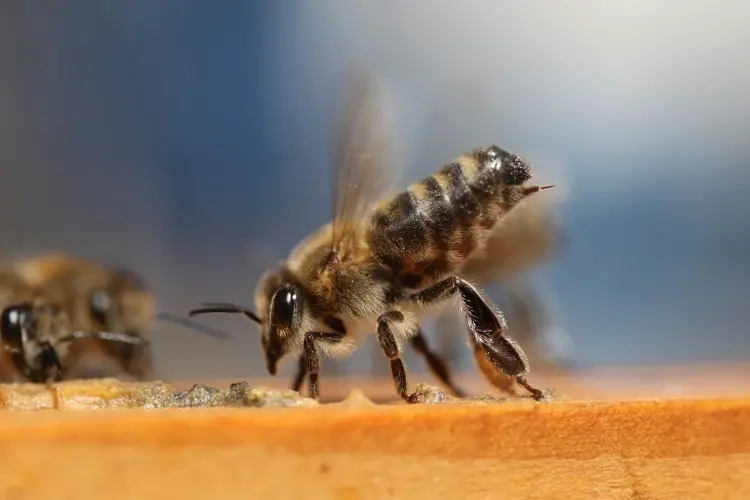Honey bees sting to defend their hive against intruders, whether human, animal, or insect. At times, they will sting you if they think you are a threat.
This is perhaps most common during a honey harvest – which is why many beekeepers use smoke before opening a hive, as it calms bees and makes them less likely to attack.
To avoid getting stung, many beekeepers also choose to wear protective clothing. Of course, this doesn’t necessarily stop bees from stinging. However, in many cases, it can stop the sting from piercing your skin.

Protective clothing won’t always prevent you from getting stung though, because bees can sting through clothes. Their ability to sting through clothes depends on the type of material you wear, as well as the thickness of the material.
How Do Bees Sting?
Bees sting using the stinger located at the end of their abdomen. The stinger has a pair of lancets that are sharp and serrated.
Piercing the skin, the lancets move back and forth, releasing the venom. The lancets operate in a sawing motion, meaning they can penetrate through clothing and into the skin.
Although bees are small, their sting is powerful enough to puncture the skin of larger predators, such as mice, rats, or bears. Because there are thousands of bees in a colony that are capable of stinging, larger animals can be stung hundreds of times to deter them from potentially harming the colony.
What Type Of Clothes Can Bees Sting Through?
Bees are capable of stinging you through thin material, especially if the material is lying firmly against your skin. This is because there is no gap between the material and your skin, and the force of the sting can penetrate both.
That’s why many beekeepers choose protective clothing made specifically to protect against bee stings. So what kinds of materials are used, and can bees sting through protective clothing?
Leather
Most beekeeping gloves are made from cow leather and have gauntlets with an elasticized top to stop bees from crawling inside. They need to fit snugly over your fingertips and hand to give you dexterity.
Because your hands are used to inspect the hive, they are the primary target for stings. Leather is thick, so it provides the best protection, but sometimes bees can sting through leather (it’s happened to me), particularly when the material is stretched tight across your skin.
Polyester Or Rubber
Cheaper alternatives to leather gloves are made of plastic or rubber, but they don’t have a protective gauntlet or sleeve. They also don’t always fit as well, so they don’t provide great dexterity when conducting a hive inspection.
As far as protecting you from bee stings, polyester or rubber is not as effective as leather, as they are not as thick. If bees can sting through leather, they’re almost certainly able to sting through polyester or rubber too.
Cotton Or Cotton/Polyester Blend
The standard protective garment (bee suit) for beekeeping is typically made from cotton or a cotton/polyester mix. Cotton and polyester are relatively thin fabrics through which bees can easily sting.
However, because a bee suit is designed to be loose-fitting for ease of movement and comfort and often has multiple layers of cotton, bees are less likely to sting you through a bee suit than tight clothing of a similar thickness.
Cotton or cotton/polyester overalls could also provide you very good protection against bee stings, as could a jacket combined with loose-fitting denim jeans.
Thick cotton socks with your pants tucked in are also effective against bee stings and can protect your ankles from getting stung.
Nylon
Netting on veils is usually made from nylon or metal gauze. It’s black, so beekeepers can see through it easily.
Bees won’t be able to sting you through thick nylon or metal gauze as long as it’s strong, stiff, and supported away from your face. Apart from your hands, your face is more likely to get stung than other parts of your body.
Netting that is soft and can’t be kept away from your face is not effective against bee stings.
Extra Protection
I wear a full-sized suit because I like to feel confident and fully protected when working with bees. Underneath, I wear lightweight, breathable clothing so I have added protection against stings.
What you wear underneath your beekeeping suit will be influenced by the type of suit or jacket you are wearing, the kind of tasks you are performing, and the type of climate you are working in. Underneath my suit, I wear clothing made from cotton because it is lightweight and cool.
Final Thoughts
Yes, bees can sting through clothes. Generally speaking, bees won’t sting you unless you do something that they perceive as a threat, such as a hive inspection.
That’s why when working with bees, it’s a good idea to consider the type of clothing you put on. Wearing layers or thicker clothing, including gloves and a hood with a strong veil, can help protect you from getting stung.
